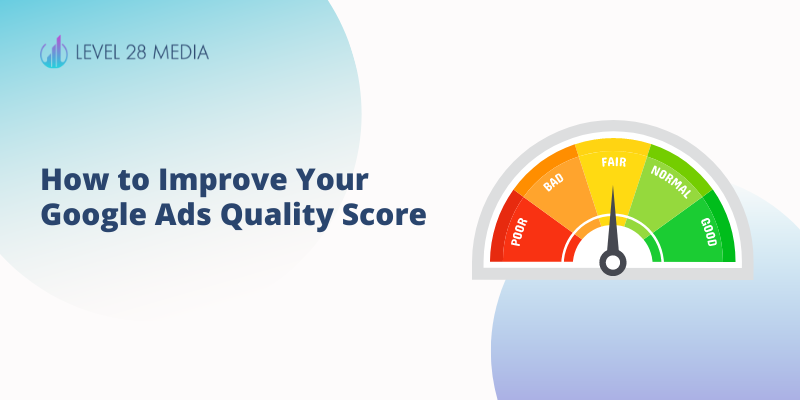It’s no secret that working on factors that improve your Google Ads Quality Score can unlock benefits, from better ad visibility to cost savings and improved ad performance. But how do you go about improving this elusive metric?
In this blog post, we’ll uncover proven strategies and insider tips that can help improve your Quality Score.
What is a Quality Score?
Quality Score is a metric that directly impacts the success and cost-effectiveness of your campaigns within Google Ads.
Google will issue a score based on the relevance of your keywords, ads, and landing page to your target audience. It considers the expected click-through rate (CTR), and landing page experience to determine your Quality Score.
The higher your Ad Quality Score, the better your ad ranking, and the more likely you will have to spend less on your cost-per-click.
How to Improve Your Google Ads Quality Score
Improve Your Ad Structure
Great ads and campaign structures start with keyword research and selecting relevant keywords that align with your target audience’s search intent.
If you have a ton of different keywords with ads that don’t match the intent of those keywords, then it’s time to revisit your campaign structure.
Organizing your keywords into tightly themed ad groups further enhances the relevance and coherence of your campaigns. This allows you to deliver tailored messaging to users, increasing the chances of higher click-through rates and improved Quality Scores.
Additionally, use keyword match types to refine your targeting and ensure your ads are shown to the most relevant audience. If you use many broad match keywords, your ads will be showing for searches that may not be relevant, so keep an eye on it and add negative keywords as needed.
Create Relevant and Compelling Ad Copy
Since Google is assessing your CTR, you need to have compelling ad copy. This may take a few adjustments and brainstorming sessions – crafting clickable ads can be challenging, but there are tips you can follow.
Think about what makes your product or service unique and find creative ways to communicate that in your copy. This be highlighting a special offer, showcasing a key benefit, or addressing a pain point.
Make sure to include your targeted keywords in your ad copy to improve ad relevance. However, be mindful of maintaining a natural flow in your copy.
For example: If you are targeting a keyword like dentist near me, adding “near me” in your ad copy will sound awkward.
Experiment with different, strong CTAs. You need to encourage users to take the desired action–this could be scheduling a consultation, contacting for a free estimate, or calling for more information.
Include Google Ads ad assets like sitelinks, call extension buttons, and location extensions to increase the chances of users clicking on your ad.
Landing Page Optimization
Since your ad Quality Score will take into account the relevance and user experience of the landing page, you need to optimize your landing page.
First and foremost, make sure that your landing page is highly relevant to the ad you’re running and the keywords you’re targeting. Aligning the messaging, visuals, and overall offer with your ad helps create a seamless experience for searches, increasing the likelihood of a conversion.
Check your landing page speed. If it loads slowly, there will be a ton of searchers dropping off before they get to see your landing page! Don’t add too many elements or images that will slow down the page.
Also, make sure your landing page is responsive. This means that it will adjust to whatever device the user has. If your page isn’t mobile-friendly, you are losing out.
Last Thoughts on Google Ads Quality Score
It takes time to improve your quality score. Like with many other marketing strategies, great results will not happen overnight! You’ll likely need to make multiple adjustments over many months.
You also need to take a closer look at other metrics such as conversion rates, cost per conversion, and impressions to get a better picture of your campaign’s overall health. At the end of the day, the number of leads and sales you get is what matters most!
Important note to remember: While your quality score is important as an overall health metric for a campaign, it should NOT be the only metric you optimize for.
You should always prioritize your lead generation metrics over Quality Score metrics because having a higher Quality Score may not necessarily contribute to more leads. Improved Quality Score can help to a certain extent but it’s important to view your performance from a high-level view instead of granularly at just the Quality Score.

Michelle Kop is a marketing consultant and award-winning pay-per-click marketing strategist. She has over 8 years of professional paid advertising experience in Google and Microsoft Ads, with a specialization in lead generation for B2B and B2C companies.
After working in corporate marketing with Fortune Global 500 Brands like Toyota and BP, Michelle founded Level 28 Media, a lead generation micro-agency for small to medium businesses.

